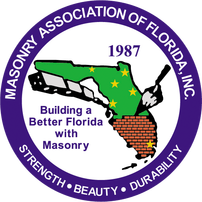|
This was a comment by a Florida Building Official on waterproofing block walls. "Masonry is by it's nature porous and is not a good vapor barrier. My assumption is that in addition to the Tyvek, some sort of siding, brick or other finished material is planned other than stucco. " What are your thoughts? You would never put tyvek on a masonry wall. I have never heard or seen such a thing. The code does not require a “vapor barrier” on cmu . Your block either has integral water repellent in combo with an exterior sealant/paint ----- or ------ it is stucco’d in which case the stucco and paint in combo with the cmu becomes the water/vapor barrier ------ or---------- you put brick on the outside with a roll on barrier ------ or---------- if you are using direct adhered stone or thin brick you use a product that seals the wall and adheres the stone or thin brick.
In all cases, other than at cracks - which need to be addressed in the design, the wall is water tight and sufficiently vapor tight to keep the interior dry.
1 Comment
Question on the apparent conflict between the section of the Fl code in 2122 requiring attachment of masonry to adjacent columns and beams and the requirements of TMS 402 B.3.2 prohibiting attachment of masonry walls for participating infill. The prohibition to connecting infill masonry to the surrounding frame in TMS 402-16 Section B.3.2 only applies to in-plane forces in participating infills. The reason is explained in the commentary for that sections which explains that this is to prevent the connectors from causing ""premature damage along the boundaries of the infill under in-plane loading (Dawe and Seah (1989a))"".
The Florida code is requiring connection for out of plane loading from wind which is also required by Section B.3.3 of TMS 402. Are there documents or articles related to the use of rodding grout cells vs vibrating them? There is currently no research or comparative discussions regarding rodding grout. The probable reason is that mechanical vibration has been required for many years by the Building Code Requirements and Specification for Masonry Structures or TMS 402/602. Puddling/ rodding is allowed in pours of 12" or less. Please review paragraph 3.5 E in TMS 602. I know of 1 or 2 jurisdictions that have waived that requirement. You can check your local building department. Another option could be to use TMS 602 paragraph 3.5 G regarding Alternate grout placement. Additional documentation:
TMS 402/602 Building Code Requirements & Specification for Masonry Structures We are working on an existing building and need to know if the exterior 8" masonry walls are 2 hr fire rated in order to make a determination as to the Building Type. The exterior walls are covered in direct applied stucco and the interior walls are covered with gypsum drywall. Can we be reasonably sure that the walls, with stucco and drywall, meet the requirements for 2 hours?
The only way to be 100% sure is to remove 6 block intact from the structure and send them to the lab to be tested to determine that they meet the requirements of C90 and what the equivalent thickness of the units are in accordance with C140. you would also need to verify that the material used in manufacturing the units is limestone. All that being said, you can make some conservative assumptions and be relatively certain that the walls meet 2 hours using the provisions of Chapter 7 of the 2017 Florida Building Code 6th Ed., Building. Since 99.9% of all block manufactured in Florida use limestone as the main aggregate you can safely assume that the block in the building are limestone based, thus requiring a 4" equivalent thickness in accordance with Table 722.3.2. The least equivalent thickness for any block regularly produced in South Florida is 3.6 inches. An example of this would be the CEMEX T007. Thus 3.6 would be a conservative assumption for the block used in a building in SW Florida. Interpolation of the table is allowed so that 3.6" gives you 100 minutes. Thus, you are .4" and 20 minutes short of your required 2 hr rating. Section 722.3.2.1 gives you directions on how to calculate the fire rating value of finishes applied to the non fire-exposed side of the wall and Section 722.3.2.2 gives you directions on how to calculate the value of finishes on the fire-exposed side. These sections refer you to Table 722.2.1.4(1) for the non fire-exposed side and Table 722.2.1.4(2) for the fire-exposed side. If there is doubt from which side the code is requiring the rating the best thing is to calculate from both side and take the least value. Conservative assumptions on the wallboard and stucco would be 1/2" wallboard and 3/8" (.375") single coat stucco (the stucco would not be to code but would be conservative for the purpose of calculating a conservative value of the fire rating). Running the calc with the fire side assumed as the exterior you get:
|
Authors:

Categories
All
Archives
May 2024
|
Masonry Resources |
MAF Websites |
Masonry Association of Florida, Inc. |PO Box 24474 , Fort Lauderdale, FL 33307
Copyright © 2017. All Rights Reserved.
Sitemap
Sitemap

 RSS Feed
RSS Feed
